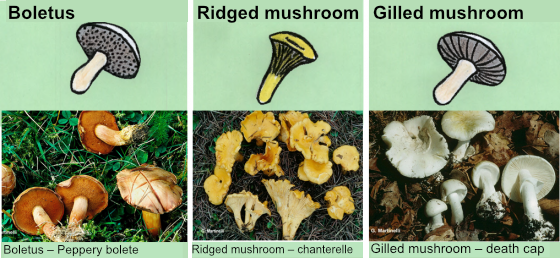- Contact Tox Info Suisse immediately if you are experiencing symptoms after eating mushrooms (unchecked mushrooms)!
- In the event of Amanita poisoning, starting treatment promptly is life-saving!
Gilled or boletus mushrooms?
Nothing more unpleasant than diarrhoea and vomiting after consuming unchecked mushrooms you have foraged!
It is not easy to judge whether you’re dealing with a harmless intolerance or the start of a life-threatening poisoning. The flesh of the consumed mushrooms i.e. the underneath of the cap may offer an indication. There are no life-threatening species among the boletes and ridged mushrooms. However, every year Tox Info Suisse records up to eight cases of poisoning from the dangerous death cap mushroom (Amanita phalloides), a gilled mushroom.
Was there a gilled mushroom?
It is not possible to identify mushrooms using pictures! The species depicted above are only for the purposes of illustration.
Look under the mushroom cap
The fruiting body of boletes looks like a bathroom sponge. One example is the porcini mushroom.
Ridged mushroom (in German Leistenpilz):
Chanterelles have ridges.
Gilled mushroom (in German Lamellenpilz):
Gills are also called lamellae, and typical gilled species include the button mushroom but also the highly toxic death cap.
To ensure mushroom foraging remains enjoyable after eating as well: Get your foraged mushrooms checked!
- You can find your nearest mushroom inspection body at vapko.ch.
- Tox Info Suisse advises against consuming mushrooms you have foraged yourself that have only been identified using a plant identification app. Mix-ups can be fatal.
Further information
Additional articles on the topic by Tox Info Suisse:
Edible mushrooms: unpleasant gastrointestinal symptoms
Kinderunfälle mit unbekannten Pilzen
Vergiftungssyndrome durch Pilze
Aktualisiert März 2023


